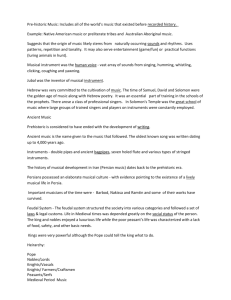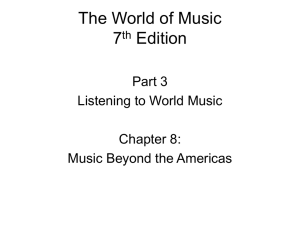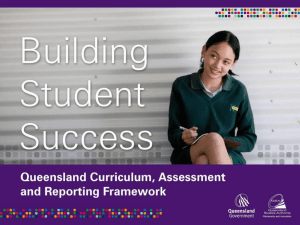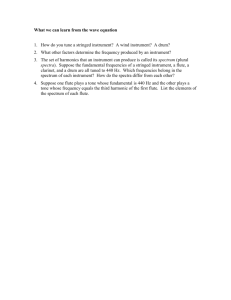Teacher guidelines (DOCX, 509 kB )
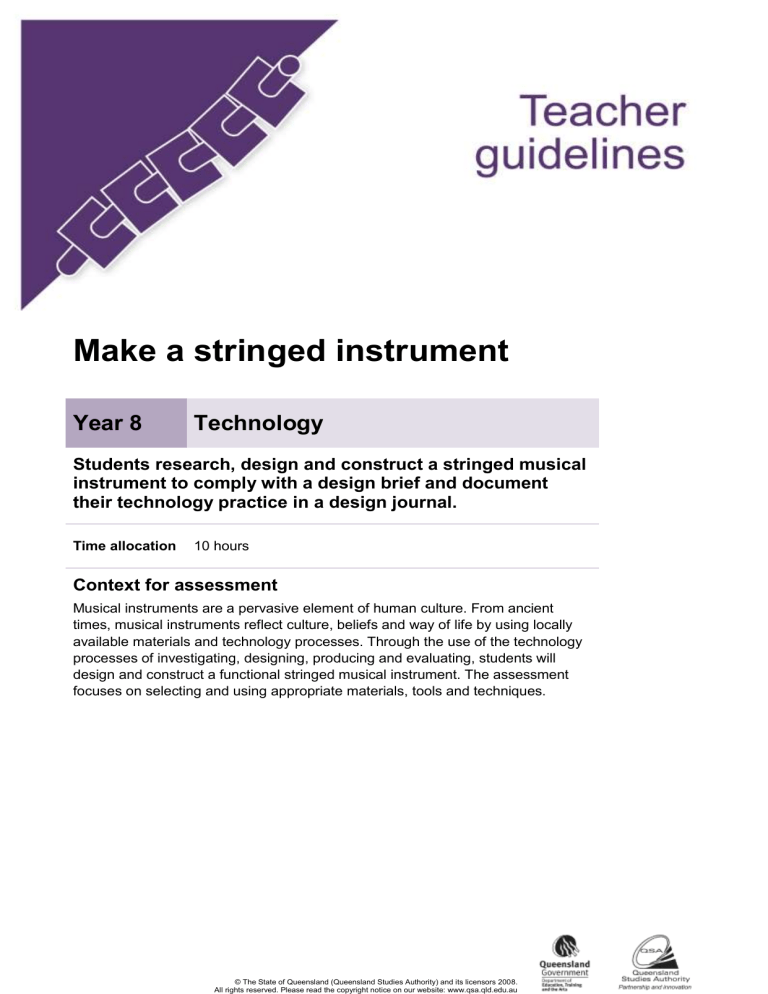
Make a stringed instrument
Year 8 Technology
Students research, design and construct a stringed musical instrument to comply with a design brief and document their technology practice in a design journal.
Time allocation 10 hours
Context for assessment
Musical instruments are a pervasive element of human culture. From ancient times, musical instruments reflect culture, beliefs and way of life by using locally available materials and technology processes. Through the use of the technology processes of investigating, designing, producing and evaluating, students will design and construct a functional stringed musical instrument. The assessment focuses on selecting and using appropriate materials, tools and techniques.
© The State of Queensland (Queensland Studies Authority) and its licensors 2008.
All rights reserved. Please read the copyright notice on our website: www.qsa.qld.edu.au
Teacher guidelines
This assessment gathers evidence of learning for the following Essential Learnings :
Technology Essential Learnings by the end of Year 9
Ways of working Knowledge and understanding
Students are able to:
investigate and analyse specifications, standards and constraints in the development of design ideas identify, apply and justify workplace health and safety practices
Technology as a human endeavour
Technology influences and impacts on people, their communities and environments in local and global contexts. generate and evaluate design ideas and
communicate research, design options, budget and timelines in design proposals select resources, techniques and tools to make products that meet detailed specifications
plan, manage and refine production procedures for efficiency
Information, materials and systems
(resources)
make products to meet detailed specifications by manipulating or processing resources
Product design and production decisions are influenced by aspects of appropriateness and by detailed specifications, constraints and standards of production.
Resources originate from different sources, exist in various forms and are manipulated to meet specifications and standards to make products.
evaluate the suitability of products and processes against criteria and recommend improvements
reflect on learning, apply new understandings and justify future applications.
Techniques and tools are selected, controlled and managed to manipulate or process resources to meet detailed specifications and predetermined standards of production.
Assessable elements
Knowledge and understanding
Investigating and designing
Producing
Evaluating
Reflecting
Source: Queensland Studies Authority 2007, Technology Essential Learnings by the end of Year 9 , QSA, Brisbane.
2
Year 8 Technology: Make a stringed instrument
Links to other KLAs
This assessment could be expanded to assess the following Essential Learnings :
The Arts — Music Essential Learnings by the end of Year 9
Ways of working Knowledge and understanding
Students are able to:
create and shape arts works by manipulating arts elements to express meaning in different contexts
modify and refine genrespecific arts works, using interpretive and technical skills
present arts works to particular audiences for a specific purpose, style and function, using genre specific arts techniques, skills, processes and cultural protocols
reflect on learning, apply new understandings and justify future applications.
Music
Music involves singing, playing instruments, listening, moving, improvising and composing by manipulating the music elements to express ideas, considering specific audiences and specific purposes, through sound.
Duration, beat, time values and metre are used to create and vary rhythm.
Pitch, tonalities, scales and intervals are used to create and vary the horizontal arrangement of sound.
Tonalities and harmonies are used to organise music in different vertical arrangements.
Interaction between the linear and the vertical arrangement of music is used to create the texture or density of sound.
Vocal, instrumental, electronic and computer-generated sound sources have characteristic sound qualities (tone colour) that can be altered through methods of production and manipulation.
Relative softness and loudness of sounds, and digital and electronic devices, are used to change dynamic levels and expression of music.
Source: Queensland Studies Authority 2007, The Arts Essential Learnings by the end of Year 9 , QSA, Brisbane.
3
Teacher guidelines
Science Essential Learnings by the end of Year 9
Ways of working Knowledge and understanding
Students are able to:
identify problems and issues, formulate scientific questions and design investigations plan investigations guided by scientific concepts and design and carry out fair tests
communicate scientific ideas, explanations, conclusions, decisions and data, using scientific argument and terminology, in appropriate formats
Energy and change
Forces and energy are identified and analysed to help understand and develop technologies, and to make predictions about events in the world.
research and analyse data, information and evidence
evaluate data, information and evidence to identify connections, construct arguments and link results to theory
select and use scientific equipment and technologies to enhance the reliability and accuracy of data collected in investigations
draw conclusions that summarise and explain patterns, and that are consistent with the data and respond to the question
An unbalanced force acting on a body results in a change in motion.
Objects remain stationary or in constant motion under the
Energy can be transferred from one medium to another.
influence of balanced forces.
Transfer of energy can vary according to the medium in which it travels.
Energy is conserved when it is transferred or transformed.
reflect on learning, apply new understandings and justify future applications.
Source: Queensland Studies Authority 2007, Science Essential Learnings by the end of Year 9 , QSA, Brisbane.
4
Year 8 Technology: Make a stringed instrument
Listed here are suggested learning experiences for students before attempting this assessment.
Conduct detailed investigations of technology products, focusing on design, materials and construction methods.
Practise using hands-on examination of a range of objects, noting details of materials and construction techniques. This will aid the design process.
Practise using tools and materials, focusing on establishing safe working practices. (See
Teacher resources for health and safety information sources.)
Practise using a journal to record investigations, design ideas, production processes, selfevaluation and reflection.
Teacher resources
Health and safety
Technology (2003) sourcebook guidelines (PDF) contains comprehensive safety guidelines in
Appendix B. This document can be found on the Queensland Studies Authority website at:
<http://www.qsa.qld.edu.au/syllabus/842.html>.
Workplace Health and Safety Act 1995 (PDF):
<http://www.deir.qld.gov.au/workplace/law/index.htm>.
“Safety Identification cartoon”, Technology Activity Book 1 , Mazurkiewicz E and Slynko B 1995,
Moreton Bay Publishing, Brisbane, pp 2-3.
Introducing technology , Slynko B 1991, Moreton Bay Publishing, Brisbane.
5
Teacher guidelines
Preparing
Consider these points before implementing the assessment.
Ensure that you have access to appropriate materials, tools and workspaces.
Ensure students have prior experience with tools and materials to develop the skills and knowledge they will need to confidently complete this challenge.
While this assessment specifically targets Technology learning, it clearly lends itself to related activities in The Arts — Music (where students would compose works to play on their instruments) and Science (energy aspects of vibrations and sound). Other potential links include SOSE (comparing music and instruments from different cultures) and Mathematics
(ratios and calculations for locating harmonics and fret placement).
This assessment lends itself to multi-disciplinary team teaching, particularly if you are linking it to other KLAs such as SOSE, Science or The Arts. You may find it helpful to invite input from others with expertise in musical instruments, workshop skills or safe working practices.
Implementation
Consider these points when implementing the assessment.
The key assessable area is the student’s journal. Ensure students have time in each lesson to record their progress in investigating, designing, constructing and evaluating.
The journal may take different forms. You could:
print out the Student booklet (students will probably need to insert extra pages for their notes and drawings)
use electronic copies of the Student booklet (this method makes it easier to include digital photos, but students may need to scan in sketches)
have students create their own electronic journal, compiling their data in a blog or
PowerPoint presentation.
6
Year 8 Technology: Make a stringed instrument
Sample implementation plan
This table shows one way that this assessment can be implemented. It is a guide only — you may choose to use all, part, or none of the table. You may customise the table to suit your students and their school environment.
Suggested time Student activity Teacher role
Section 1: Investigation
3 hours Research stringed instruments.
Identify design problems and look for ways they have been solved (e.g. how to attach strings, how to change the tuning, how to make it louder).
Test materials and design ideas.
Make notes of all activities in their journal.
Model investigation process and use of journal for recording findings.
Section 2: Design
90 minutes Develop and document a design for their instrument, including a list of materials and details of important solutions.
Section 3: Production
Model production of labelled design drawings.
4 hours Construct and test instrument. Revise and model safe work practices.
Organise tools and construction materials (see Resources for the assessment for suggestions).
Section 4: Evaluation
1 hour Complete the Evaluation page in the
Student booklet
Present instrument to group for discussion and critique.
Section 5: Reflection
30 minutes Complete the Reflection section of the
Student booklet .
Reflect on initial criteria as basis for evaluation.
Model and facilitate peer assessment.
7
Teacher guidelines
Resources for the assessment
Appendix A Stringed instrument analysis
The following resources provide a starting point for exploring a diverse range of instruments; however examination of real instruments will be much more helpful.
Websites:
Queensland Museum: <www.mms.qld.edu.au/musical-instruments/index.htm>.
Oddmusic: <www.oddmusic.com>.
Science of sound: Hands on activities: <www.smm.org/sound/activity/handson.htm>.
Indiana University School of Music:
<http://library.music.indiana.edu/music_resources/instr.html>.
Books:
Making musical instruments from junk , Penny, N 2005, A & C Black Publishers Ltd, London.
Musical instruments , Gogerly, L 2004, Hodder Children’s Books, London.
Making gourd musical instruments: Over 60 string, wind & percussion instruments & how to play them , Summit, G & Widess, J 2007, Sterling, New York.
Making music , Wiseman, AS and Langstaff, J 2003 Storey Kids, North Adams.
Suggested tools
Handsaws, hacksaws, scissors, trimming knives
Hand and/or electric drills
Files, rasps, sandpaper and sanding blocks
Bench vices and clamps
Screwdrivers
Hammers
Suggested construction materials
Wood — various shapes and sizes including ply and dowel
Plastics — acrylic sheet, various diameter PVC pipes, recycled containers
String materials — wire, twine, cord, solid nylon (e.g. heavy fishing line, “weed-eater” line)
Fasteners — screws, nails, bolts, glues, staples
Any other recycled materials that may be useful (e.g. tins, leather off-cuts, miscellaneous hardware including hinges, catches, knobs etc.)
8
Year 8 Technology: Make a stringed instrument
During the learning process, you and your students should have developed a shared understanding of the curriculum expectations identified as part of the planning process.
After students have completed the assessment, identify, gather and interpret the information provided in student responses. Use only the evidence in student responses to make your judgment about the quality of the student learning. Refer to the following documents to assist you in making standards-referenced judgments:
Guide to making judgments
Indicative A response
Sample responses (where available).
Making judgments about this assessment
Note that the assessment should focus on the process the student negotiates rather than the finished product. For this reason, the journal is the key source of evidence rather than the student’s instrument. It is possible for a student to demonstrate high levels of knowledge, understanding and working without actually completing a successful instrument. Conversely, it is possible to produce a successful instrument without demonstrating the significant elements of the process.
For further information, refer to the resource Using a Guide to making judgments , available in the Resources section of the Assessment Bank website.
Evaluate the information gathered from the assessment to inform teaching and learning strategies.
Involve students in the feedback process. Give students opportunities to ask follow-up questions and share their learning observations or experiences.
Focus feedba ck on the student’s personal progress. Emphasise continuous progress relative to their previous achievement and to the learning expectations — avoid comparing a student with their classmates.
For further information, refer to the resource Using feedback , available in the
Resources section of the Assessment Bank website.
9
Appendix A
Stringed instrument analysis
This sheet will help you look closely at the design of instruments. If you can’t find real ones to analyse, use books or websites.
Instrument: ........................................................................................................................................
(If you don’t know what it’s called, make up a suitable name)
Design:
How do you make a sound (e.g. pluck, bow, hit)?
How do you play different notes?
Strings:
What are the strings made of?
How are they attached?
How are they tuned?
Sound:
Does this instrument have some way to amplify the sound?
Not all instruments have this — circle and describe if you can find one:
Soundboard (like a piano)
Hollow chamber (like a guitar or drum)
Stretched skin (like a drum or banjo)
Electronic amplification
Other:
Appendix A
Construction:
What materials are used?
What can you tell about how it was put together (e.g. screws, glued joints, bolts, pegs)?
Sketch some close-ups that show design solutions.


